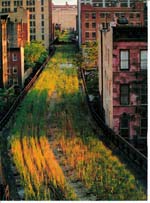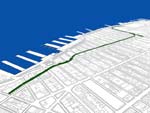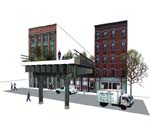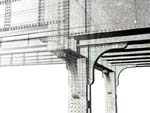
|
|
|
|
 |
|
Home Site Search Contact Us Subscribe
|
|
|
|
UPDATE 07/16/03: Designing the High Line: Competition Insights - and Results
17 winners and 720 entries now online… Three jurors, the competition coordinator, and Friends of the High Line co-founders offer their thoughts about - and hopes for - one of Manhattan's most unique urban environments. by Claire Weisz, AIA April 21, 2003 Update
07/16/03: There
were 17 winners and honorable mentions in the Designing the High Line
competition. They – and all 720 entries from 36 countries can be viewed at: DESIGNING THE HIGHLINE. About
150 of the entries, including the winners, are on exhibit in Vanderbilt Hall at
Grand Central Terminal through July 26. The exhibition – designed by Ada Tolla and Giuseppe Lignano of LOT/EK
Architecture, Gary Handel, AIA, of Gary Edward Handel + Associates, and Paula
Scher of Pentagram – is definitely worth wandering through if your in town. Original feature: Editor’s note: The High Line is a 1 ½-mile-long elevated freight
railway line that runs from West 34 Street south to the Meatpacking District on
Manhattan’s far West Side. Built in the 1930’s, it has been unused since 1980 –
and under constant threat of demolition. Friends of the High Line (FHL), a
non-profit coalition of local residents, businesses, and
civic groups established in 1999, is dedicated to not only preserving
the structure, but also to transforming it into a grand public promenade. To that end, FHL recently launched “Designing the High Line,”
an open, one-stage ideas competition for the structure’s reuse. April 25 is the
early-bird registration deadline (with a $50 entry fee – after that, entries
will cost $100 each). The final deadline for registration and submissions is
May 23. (Click on link above for details and registration.) The jury includes: *Julie Bargmann,
D.I.R.T. Studio, Professor of Landscape Architecture at the University of
Virginia; *Vishaan Chakrabarti, Director of Manhattan Office, New York City
Department of City Planning; John Lee Compton, Co-Chair, Chelsea Preservation
and Planning Committee, Manhattan Community Board No. 4; Lynne Cook, Curator,
Dia Art Foundation; *Steven Holl, AIA, Architect; Murray Moss, Owner, Moss;
Marilyn Jordan Taylor, FAIA, Chairman, Skidmore, Owings & Merrill; Signe
Nielsen, FASLA, Landscape Architect and Urban Designer; Bernard Tschumi, AIA,
Architect, Dean of the Columbia University Graduate School of Architecture,
Planning, and Preservation; and *Robert Hammond, Co-Founder, Friends of the High Line. *Reed
Kroloff, former Editor-in-Chief of Architecture magazine, is the competition
advisor. (* = Interviewed) The
interviews that follow were conducted by Claire Weisz, AIA, Principal of Weisz
+ Yoes, and Co-Executive Director of the Design Trust for Public Space. Reed Kroloff, Designing the High Line Competition
Advisor Claire Weisz: What do you think is important about the
High Line? Reed Kroloff: What I think is important about the High
line is its height. You have this remnant at an unnatural height, a fantastic
otherworldly space. You can wander through New York at a magical mid-level. It
is really an unparalleled opportunity. The question is what can you do with
this to let people take advantage of it? CW: What kind of urbanism is the High Line? RK: The High Line is distinct because it
cuts right through the grid. Only the subways here do that. It allows you to
really experience the grid unlike anywhere else. Your urban perception is
shifted – a split-space urbanism – with the ability to move through buildings,
too. CW: Why a design competition? RK: Right now, it’s not accessible and not
clean. There is the opportunity to create architecture in the city in a way it
can’t be created anywhere else. A competition should show us many ideas about
what is possible before plans are set. CW: Is it Architecture or Landscape? RK: It is Architecture because it is a
bridge structure, but it has become Landscape through neglect. Now, there is a
sense of not just preserving but enhancing the condition of this structure and
the place it has become – without turning it into a “Disney experience.” It has
to be celebrated for what makes it distinct. It reminds me of the drawings
David McCauley does of cities transforming into other things. This competition
about a neglected structure is a wonderful vindication of the preservation
program in New York. It is remarkable that when it was threatened, a group of
citizens rose up and said “No!” People want to keep a piece of the city – what
it was in early incarnations. And now we have the competition to show us how to
use it in the 21st century. Steven Holl, Architect – Juror Claire Weisz: What do you think about when you look at
the High Line now? Steven Holl: I believe that its real potential lies in what I’d call a public-private hybrid: eventually realizing a variety of enterprises and functions that install themselves along its length. An example is how the High Line works in the project that Jean Nouvel proposed in the Meatpacking District last year. It demonstrates the possibilities that can exist at the upper level when an architect is interested in doing interesting things. This would give the High Line energy beyond that of being purely a public project. If you could engage adjacent interests in being responsible for pieces of it, for maintaining it, for having events and activities up there, then this kind of thinking will really make the High Line vital. I see this upper passage getting its richness from a crazy quilt of different uses and places. For example,
imagine just walking along, and parts of it are wild. At another section, they
are using it as part of a building. They’ve repaved and formed it into a place
where you can have a fashion show one day or stop to have lunch – and it glows
with lighting from underneath. And then walk another block, and it goes back to
being wild. There must be some ways that you can – say for 10 hours a month –
use it for special events. Look at Bryant Park – why does it work there? Bryant
Park is a great example of a park and that’s fine – but it’s a great place
because it has the other things going on. What we can’t
neglect is the underside of it. It can really be quite nice. Like what was done at the car wash on 14th
Street. You can use lighting and glass, and it can be
really something useful. But as I see it, it needs to have both the public
and private sectors working on it together. Vishaan Chakrabarti, Department of City
Planning, NYC - Juror Claire Weisz: What are some of the issues that City
Planning would like to see the competition address? Vishaan Chakrabarti: I think that the most radical concept is
that this could be a successful public space that’s elevated in section. There
are so few examples that work. How do you get people wanting to go up there?
What is the programming? Wonderful possibilities exist that relate to what is
below the High Line and what is happening on the side streets. We hope that the
entries will deal with these issues. CW: What do people need to know about the neighborhoods that the High Line bisects? VC: In addition to lower Manhattan, one of
the largest planning projects the city will ever undertake is the Hudson Yards,
which stretches over the area just north of the High Line. One of our
objectives is the creation of a vast open space network, in which the High Line
plays a big role. You could walk from the Meatpacking District to Clinton on
one continuous public open space. The High Line can serve as a great connector
into the core of Hudson Yards – the knuckle of the plan – where all the
districts come together in a public square. It is really like the Bryant Park
of the far West Side. The High Line charges right into that. If you continue on
the High Line to the west, you will be out on the water. To the east, the
network connects the High Line to Penn Station. CW: Are you saying that you are formally
planning for that core New York activity: walking? VC: Yes. And the High Line is an incredible
walkable connector. But there are other planning issues involved. We certainly
envision the ongoing uses of the arts district in the mid-blocks of far West
Chelsea, and along the avenues we see a potential for residential uses. The
High Line is surrounded by buildings that make sense in terms of their use and
form – we are very excited about the possibilities. What I’m really hoping is that the competition will focus on the High Line itself: its structure, its conditions, and getting up to it. It is trite to say, “This is a linear park.” What does that mean? You can imagine the surface being a hundred different things, and the program as well, from jogging to retail. You look at it and wonder: should it speak to a more rugged experience of wildflowers or a more refined, elegant, planted park? We are only at the tip of the iceberg of understanding what “linear park” might mean here: a public space of this length in this place. Julie Bargmann, Landscape Architect - Juror Claire Weisz: What is the main landscape challenge that the High Line presents? Julie Bargmann: The challenge is to defend the value
of this amazing landscape infrastructure in every sense, including
ecologically. I was among all the folks who barely knew what the High Line was.
Then I saw it when I went to an initial site visit at Penn Yards, and it was it
epiphany. It has to be saved. As a landscape architect, never in a million
years could I design anything as thrilling or beautiful. Then I met Robert
Hammond and was introduced to all the political problems facing its survival.
That fueled the fire for me to go to the mat for it. So basically, the hope I
have for the role of the High Line in relation to the Penn Yards site and
beyond is to have a connector both physically and historically, and to hold a
piece of the public realm within something that the community perceived as a private
development, and build it as a public amenity. CW: What issues are you hoping the competition will address? JB: As the
guidelines express, what are the connections to and away from the High Line? How
can it weave together other landscape initiatives in the city such as Hudson
River Park and important streets and avenues? And, of course, I’m very
interested in the exploration of urban ecology and how this 1.5-mile ecological
corridor gives us something to experiment with. It should be something that
looks at the particular and peculiar, as opposed to "shrubbing it up.”
Here, even the native plant discussion has an urban twist. There is no real
definition of the NYC "native landscape.” I'll look at a plant palette
that may show pre-settlement plant communities, but what does that have to do
with the New York plant community? The other thing is recognizing the High Line
as 1.5 miles of open space with no intersection with motorized traffic: people
should see this in the same light as Central Park, which is also a piece of
landscape infrastructure. I would hope that not only will there be cultural
idiosyncrasies but ecological and environmental idiosyncrasies as well. CW: What about change? JB:
Landscape on this platform in an urban setting is a special and exaggerated
microclimate. How do you deal with an extreme landscape that goes through so
many different circumstances? You are talking about daily changes, not only
seasonal changes. We are more conscious of
changes over time – the decade clock, the geological clock. Especially when you
look at it in terms of the average life of a tree, which in New York is seven
years, while elsewhere trees survive 50 or 100 years. There is a lot more
consciousness of how succession works: how weedy this landscape is in its in
early succession, how that landscape will evolve, and perhaps even need to be
reset or disturbed. If you imagine and build the right landscape
infrastructure, the city will grow the right way around it. I think a lot about the urban wilds, though maybe the
general public is not ready for this. Abandoned and vacant lots really do have
a peculiar life and quality of their own. When Penn Yards came up, I thought,
how can retain some of this wildness? That’s where the fight is very hard, but
I think that's catching on. Ecologists are beginning to appreciate urban
ecology in terms of its value as a landscape experience. Central Park isn’t the
only paradigm, but it is important to think that this generation can understand
landscape infrastructure on this scale with different concerns. There are urban
and wild qualities to the High Line. How do you capture that and not over-tame
or cultivate it? Joshua
David and Robert Hammond (Juror) Co-Founders, Friends of the High Line Claire Weisz: Why did FHL need to do this competition? Joshua David: The High Line is a completely
unique entity that has no direct precedents – except perhaps the Promenade
Plantée [a reclaimed elevated rail viaduct in Paris] – and we wanted to make
sure that every possible design idea was put on the table before we moved to
the next step. Robert Hammond: There is not just one discipline
that covers all the aspects of the project. It includes landscape, gardens,
lighting, architecture – everything. We wanted to create a way for talented
people to team up – a lighting designer and an architect, a horticulturist and
a landscape architect, an artist and city planner, or any other combination of
disciplines. And a good design will help get the High Line built. It will help
FHL overcome the legal, political, and financial hurdles that lay before us. CW: What is the role of
the architecture and design community? RH: When we started this project, most people thought we
were crazy and that it would never move forward. Architects and designers
recognized the vision early on and gave us the critical backing we needed to
gain broader support. I think they will play an even more important role now.
By developing visionary ideas, they will help us build political and financial
support for the project. FHL has spent a huge amount of time and energy on this
project. It is not enough to build just an average park. We want the space to
be as amazing as the structure itself. CW: What would you, personally,
like to see up there? RH: My love of the
High Line comes from its contractions – the juxtaposition of seemingly
incongruous elements – a pastoral meadow atop an industrial infrastructure. I
hope to see designs that reflect these kinds of contradictions. I love the
metaphor of a bubbling brook that runs through the heart of the Meatpacking and
West Chelsea art districts. I am interested in preserving an essence of what
happens when people leave and the wildness takes over – and
at the same time gives people access to this wild environment. CW: What is the toughest challenge? JD: A really important challenge is dealing with access.
The High Line’s value can only be realized when the public can get up on it.
Access is what will connect the two worlds created by the structure: the great
spaces on top and below. How do you create access systems that are
ADA-compliant and can land on a narrow sidewalk? How do you build public access
through buildings next to the High Line? This is a good time to point out that
currently, unfortunately, there is no public access to the Line’s upper deck.
It is owned by the CSX Corporation, and it’s private property. Some people have
been sneaking up lately. This is a bad idea. FHL discourages it in the
strongest terms. It is illegal – you will be arrested. And it hurts our efforts
to negotiate with the railroad to open it to the public. RH: Some people view the spaces below the line, as it
crosses over the street, as a negative condition, but a good design could
completely change this perception. CW: How should entrants
treat adjacent buildings? RH: The competition is focused on the High Line more
than adjacent buildings. We hope entrants will submit proposals that concentrate
on the elevated structure itself – the way access might be developed and
programming for the Line, rather than focusing on the design of buildings
around the Line – though we are interested in seeing how access might be built
into adjacent buildings. But for the most part, it’s not about a lot of new
buildings. It’s really about creating a new public space that works. The
community regularly voices its concerns about significantly increasing density
in the area, or creating building forms that are excessively tall or bulky.
None of our studies show that increased density in the area was required to
make reusing the High Line viable. People in the area want to preserve the
essential neighborhood character, and the High Line is an important piece of
the character. CW: What about
transportation uses? JD: We see pedestrian transportation use as the most feasible
and the most desirable. It is essential that we never forget that the High
Line, at base, is a piece of transportation infrastructure. The great thing
about rail-banking is that it allows us to use the structure for pedestrian
transportation now, while at the same time allowing for other forms of
transportation in the future if that ever becomes desirable or necessary. CW: What kind of resources do you have available for competitors? RH: Everything is on the website www.thehighline.org/competition:
the guidelines, research and resources, images, a list of existing flora,
registration, AutoCad drawings, and other relevant materials. Remember to
register by April 25 to avoid a late fee. CW: What are you planning for the Exhibition? RH: We are planning to exhibit as many entries as possible in
Grand Central Terminal’s Vanderbilt Hall, July 10-26. Grand Central has great
historic and symbolic connections to the High Line, and half a million pass
through it everyday. There will be a panel discussion with the jury once the
exhibit is mounted. There will be lots of press attention, since this will be
the first time we are showing design concepts for reuse. CW: What are the requirements? JD: The requirements are really simple. Submit two boards – no models, no videotapes – that
address the competition objectives: Define a comprehensive vision for the High
Line as a whole; identify innovative ways to deal with access; present ideas
for the spaces below the Line; and create a compelling public environment on
the structure’s elevated rail bed. Claire
Weisz, AIA, is a New York based architect and principal in the firm of Weisz +
Yoes. She is also the Executive Director of The Design Trust for Public Space.
Originally from Canada, she has practiced in California and taught urban design
and architecture at Columbia University and The Pratt Institute. |
(click on pictures to enlarge)  (Ken Smith/Ken Smith Landscape Architect) The High Line today (Courtesy Friends of the High Line) - (Proun Space Studio) The "green" line (Proun Space Studio) A view below (Proun Space Studio) Detail |
© 2003 ArchNewsNow.com